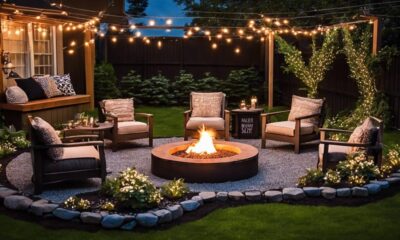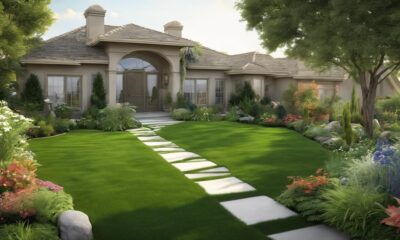Architecture Home Styles
10 Cons of Modern Homes You Should Consider
Torn between the allure of modern homes and their drawbacks? Uncover the hidden cons that might reshape your perspective on contemporary living.

In considering the drawbacks of modern homes, it's prudent to acknowledge certain aspects that may not align with everyone's preferences. While modern homes boast efficiency and contemporary design, there are nuanced issues that go beyond the surface appeal.
From maintenance challenges to concerns about depersonalized living spaces, these cons shed light on the complexities of modern living. As we explore these 10 cons, a deeper understanding of the trade-offs involved might emerge, prompting a reassessment of our ideals when it comes to the place we call home.
Key Takeaways
- High-tech features lead to costly maintenance and frequent updates.
- Health risks like indoor air pollution and mold are prevalent.
- Location greatly influences resale value and desirability.
- Limited personalization options may make modern homes feel impersonal.
Maintenance Challenges
Regularly maintaining modern homes can present unique challenges due to the specialized features and materials used in their construction. These specialized maintenance needs can significantly impact maintenance costs for homeowners. From smart home systems to energy-efficient appliances, modern homes require specialized care to ensure optimal functionality.
The use of unique materials like concrete floors and metal roofing also adds to the maintenance challenges homeowners face.
Additionally, modern amenities such as solar panels and high-end HVAC systems demand regular upkeep, further contributing to maintenance costs. The sleek and minimalist design of many modern homes also necessitates specific cleaning techniques to preserve the aesthetic appeal.
Moreover, the advanced technology components found in modern homes may require professional assistance for repair or replacement, adding another layer of complexity to maintenance tasks.
It is essential for homeowners to consider these specialized maintenance requirements when investing in a modern home to accurately budget for ongoing upkeep and ensure the longevity of their property.
High Tech Malfunctions

Maintenance challenges in modern homes can escalate when high-tech malfunctions disrupt daily routines and require specialized expertise for troubleshooting and repair. High-tech malfunctions can lead to unexpected repair costs, catching homeowners off guard.
Smart home systems, designed to make life more convenient, may experience connectivity issues or software glitches, causing frustration and inconvenience. Malfunctions in high-tech appliances like refrigerators or HVAC systems can significantly disrupt daily routines, especially in households heavily reliant on technology.
The complexity of troubleshooting and repairing advanced technology in modern homes often necessitates specialized expertise, adding another layer of difficulty and potential expense. Homeowners may find themselves at the mercy of technicians with specific training in these technologies, leading to delays in resolving issues.
The reliance on technology in modern homes, while offering many benefits, also comes with the downside of increased vulnerability to high-tech malfunctions and the associated challenges they bring.
Lack of Individuality
Modern homes often suffer from a lack of individuality, stemming from their standardized design elements and minimalist aesthetics that diminish opportunities for personal expression. In the realm of contemporary housing, the desire for efficiency and uniformity sometimes overshadows the need for uniqueness and character in homes. Let's delve deeper into the repercussions of this lack of individuality in modern homes:
| Challenge | Description | Impact |
|---|---|---|
| Standardized Designs | Many modern homes feature cookie-cutter designs that lack originality. | Diminished sense of personalization. |
| Limited Customization | Homeowners have few options to customize their modern homes according to their unique tastes. | Inability to reflect individual preferences. |
| Homogenous Look | Similar modern properties in a neighborhood can blend together due to mass-produced designs. | Reduced diversity and creativity in housing aesthetics. |
| Impersonal Feel | The uniformity of modern homes can make them feel cold and impersonal. | Lack of warmth and personal touch. |
The lack of individuality in modern homes can stifle creativity and self-expression, leading to a housing landscape that sometimes lacks the vibrancy and diversity that many homeowners seek.
Expensive Upkeep
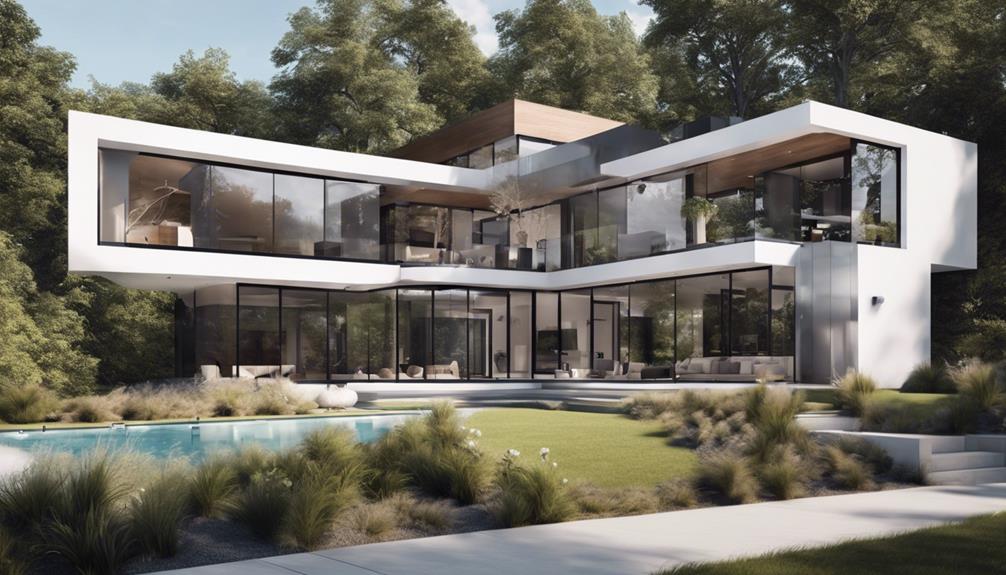
Modern homes often come with a hefty price tag for maintenance and repairs, especially when intricate systems and advanced technology are involved. These high-tech features may require specialized professionals and frequent updates, contributing to the overall expensive upkeep.
The ongoing costs of maintaining a modern home can quickly add up, making it a significant financial consideration for homeowners.
High Maintenance Costs
With the intricate and high-tech features found in contemporary residences, the financial burden of maintaining these cutting-edge amenities can be significantly demanding. Modern homes, equipped with premium features like smart home automation and energy-efficient appliances, often come with higher maintenance costs. These advanced systems may require costly repairs or replacements over time, impacting the overall affordability of owning such a property.
Additionally, the sleek design of modern homes, while aesthetically pleasing, can entail expensive upkeep to preserve both the look and functionality of the house. Homeowners of modern homes should be prepared to budget for ongoing maintenance expenses to ensure the longevity and efficiency of their property. It's essential to consider these high maintenance costs as part of the overall investment in a modern home.
Costly Repairs
Repairing and maintaining high-tech features in contemporary residences can lead to considerable financial strain due to the costly upkeep associated with these advanced amenities. Modern homes often require expensive repairs and upkeep due to the utilization of high-end materials and advanced technology. Here are some key points to consider regarding the costly repairs in modern homes:
- Maintenance expenses for modern homes can be significantly higher compared to traditional homes.
- Specialized professionals may be needed for repairs and upkeep of modern home features, increasing costs.
- Modern amenities like smart systems or integrated technology can be expensive to repair or replace.
- The upfront investment in modern homes may not always account for the long-term maintenance expenses, leading to financial strain.
Limited Outdoor Space

Given the trend towards smaller yards and limited outdoor space in modern homes, it's essential to recognize the potential drawbacks associated with this design choice. Limited outdoor space can significantly impact the lifestyle and activities one can enjoy at home. Smaller yards restrict the opportunities for gardening, outdoor entertaining, and engaging in recreational activities. For individuals with pets or those who relish spending time outdoors, the constraints of limited outdoor space can pose challenges and hinder their quality of life.
Moreover, the reduced outdoor space in modern homes may diminish property value and resale potential, particularly in regions where outdoor living is highly prized. The lack of ample outdoor space limits opportunities for relaxation, exercise, and connecting with nature, affecting not only physical well-being but also mental health. As the demand for outdoor living areas grows, the limitations imposed by smaller yards in modern homes may become more pronounced, highlighting the importance of carefully considering the outdoor space available when selecting a home.
Health Risks

Indoor air pollution in modern homes poses significant health risks, with levels up to five times worse than outdoor air quality. This alarming fact highlights the potential dangers lurking within our own living spaces. Here are some key points to consider:
- Chemical Off-Gassing: New materials and furniture in modern homes release harmful chemicals that can lead to respiratory problems.
- Lack of Natural Ventilation: Sealed windows and poor ventilation systems can trap indoor pollutants and allergens, exacerbating health issues.
- Mold and Mildew: Synthetic materials used in modern homes provide a breeding ground for mold and mildew, which can trigger respiratory problems and allergies.
- Electromagnetic Fields (EMFs): High levels of EMFs from modern technology and appliances may have adverse effects on our health, raising concerns about long-term exposure.
Awareness of these health risks associated with indoor air pollution and chemical off-gassing in modern homes is crucial for making informed decisions about our living environments.
Resale Value Concerns
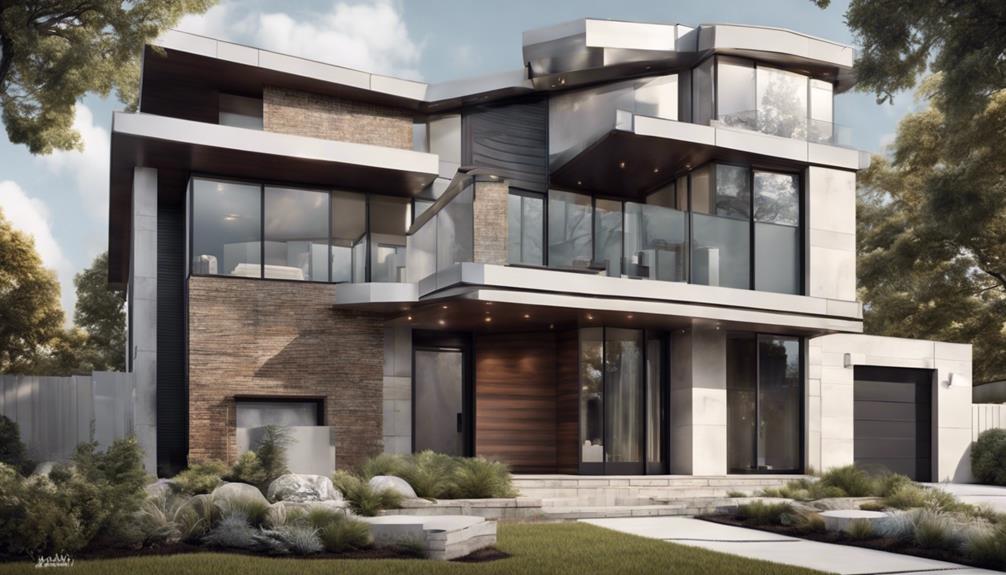
Modern homes can face challenges in the resale market due to fluctuating trends and evolving design preferences. The impact of location on property value is significant, with less desirable areas potentially affecting the resale value of modern homes.
These factors underscore the importance of carefully considering the long-term investment potential when purchasing a modern home.
Resale Market Fluctuations
Resale market fluctuations present a significant concern for homeowners of modern properties, impacting the potential resale value of these homes. When considering the resale market, there are specific factors to be aware of:
- Impact on Value: Fluctuations can lead to unpredictable changes in the resale value of modern homes.
- Unique Features: Niche or unique modern home features may not appeal to a broad range of buyers, affecting resale potential.
- Technological Advancements: Rapid changes in technology can quickly render modern home features outdated, reducing their value.
- Neighborhood Influence: Neighborhood trends and preferences can significantly influence the resale value of modern homes, causing fluctuations in prices.
Being mindful of these dynamics is crucial for homeowners seeking to maximize the resale value of their modern properties.
Location Impact on Value
Understanding the pivotal role that location plays in determining the resale value of contemporary homes is essential for savvy homeowners looking to maximize their investment returns. Proximity to amenities, schools, and transportation can significantly impact the desirability of a modern home. Modern homes located in popular or up-and-coming neighborhoods tend to command higher resale values due to increased demand. When assessing resale value, it is crucial to consider the potential for future developments or changes in the area that could affect property values. Neighborhood trends and overall market demand also play a vital role in determining the resale value of modern homes. By staying informed about location impact on value and neighborhood trends, homeowners can make more strategic decisions to enhance their property's resale potential.
| Location Impact on Value | Resale Value Concerns |
|---|---|
| Proximity to amenities, schools, and transportation | Higher desirability |
| Popular or up-and-coming neighborhoods | Increased demand |
| Potential for future developments or changes in the area | Impact on property values |
Noise Pollution
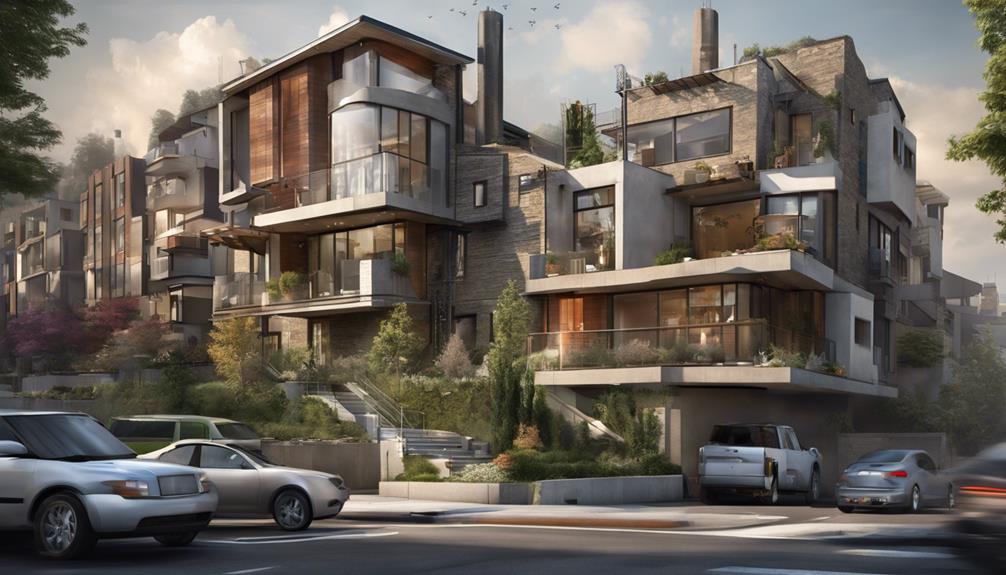
Experiencing frequent disturbances due to noise pollution is a common concern among residents of modern homes. This issue arises due to inadequate soundproofing measures, thin walls, and large windows that fail to block out external noise effectively.
Urban areas, where modern homes are prevalent, often face heightened levels of noise pollution, further exacerbating the problem for inhabitants. The impact of noise pollution goes beyond mere annoyance, affecting the residents' quality of life, disrupting their sleep, and taking a toll on their overall well-being in modern living spaces.
Key Points to Note:
- Modern homes may lack proper soundproofing, leaving them susceptible to noise pollution.
- Thin walls and expansive windows can allow external noise to infiltrate indoor spaces easily.
- Urban settings where modern homes are situated tend to have elevated levels of noise pollution.
- Noise pollution can have adverse effects on residents' daily lives and health, emphasizing the need for mitigation strategies like soundproofing materials and double-paned windows.
Energy Consumption Issues

Modern homes present challenges in terms of energy consumption, leading to high electricity bills and environmental concerns. Sustainability becomes a critical issue as the extensive use of technology and appliances contributes to increased energy usage.
Heating, cooling, lighting systems, and smart home devices all play a role in escalating energy consumption in modern households.
High Electricity Bills
In today's modern homes, the high electricity bills often stem from energy-intensive features such as centralized air conditioning, home automation systems, and large windows. When contemplating the costs associated with high electricity bills in modern homes, it's essential to consider various factors:
- Energy-intensive features like centralized air conditioning can significantly contribute to high electricity bills.
- Advanced technology and smart home devices may lead to increased energy consumption, impacting electricity costs.
- Sustainable design elements can help offset energy consumption but may not completely alleviate high electricity bills.
- Individual usage habits and lifestyle choices play a crucial role in determining the overall impact of modern home features on electricity expenses.
Environmental Impact Concerns
Considering the energy-intensive features and technological advancements prevalent in modern homes, the environmental impact concerns related to energy consumption become a significant focal point for sustainability-minded homeowners. Modern homes often incorporate energy-efficient appliances and green building practices to mitigate their environmental footprint. Sustainable building materials play a crucial role in addressing energy consumption issues and reducing the overall impact on the environment. Proper insulation and energy-saving design features further help minimize the energy consumption of these homes. By being mindful of energy consumption and utilizing sustainable building materials, homeowners can contribute to a more eco-friendly living space.
| Energy Consumption Solutions | Environmental Impact Benefits |
|---|---|
| Energy-efficient appliances | Reduced carbon footprint |
| Sustainable building materials | Lower energy consumption |
| Green building practices | Enhanced environmental sustainability |
| Proper insulation | Minimized energy waste |
| Energy-saving design features | Increased energy efficiency |
Sustainability Challenges
High energy consumption in modern homes presents a pressing sustainability challenge that stems from the integration of advanced technology and the expansive nature of contemporary living spaces.
When considering sustainability challenges related to energy consumption in modern homes, it's crucial to acknowledge the following key points:
- Modern homes may face sustainability challenges due to high energy consumption from advanced technology and large living spaces.
- Energy-efficient appliances and design features may not fully offset the overall energy demands of modern homes.
- Heating, cooling, and lighting systems in modern homes contribute to significant energy consumption levels.
- Sustainability issues in modern homes can lead to higher utility bills and environmental impact.
Finding a balance between comfort and energy efficiency remains paramount in addressing these sustainability challenges.
Depersonalized Living Environment
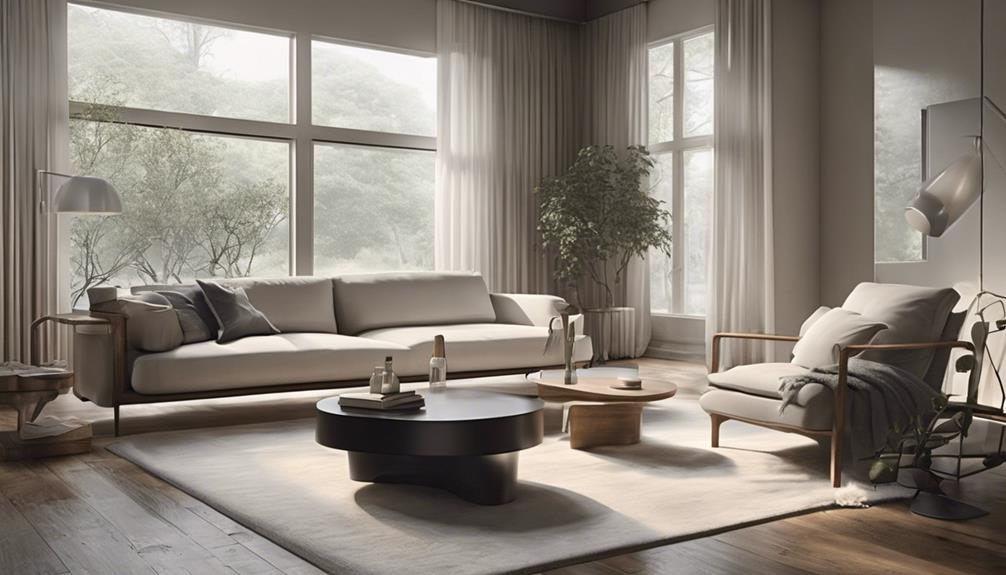
Despite the sleek aesthetics and functionality that characterize modern homes, their minimalist design and lack of character often result in a depersonalized living environment. The emphasis on clean lines and modern features can create a sterile living space that lacks warmth and coziness. Limited options for personalization in modern homes can make it challenging for individuals to infuse their unique personality into the living space, leading to a sense of detachment and impersonality.
The minimalist design of modern homes, while visually appealing, can sometimes strip away the elements that make a house feel like a home. The focus on simplicity and efficiency may overlook the importance of sentimental items, personal touches, and individual style that contribute to a personalized and inviting living environment. Without these elements, modern homes run the risk of feeling cold and unwelcoming, detracting from the overall comfort and coziness that many seek in their living spaces.
Frequently Asked Questions
What Are the Disadvantages of Modern Homes?
When it comes to the disadvantages of modern homes, some key aspects to consider include:
- The premium price tag for all the sleek features and technology.
- Limited personalization options compared to more character-filled homes.
- The potential for maintenance costs to be higher in the long run.
Additionally, the minimalist design of modern homes may not appeal to everyone, with some finding them sterile or lacking in warmth and personality.
What Are 3 Advantages and 3 Disadvantages of Buying a Home?
When it comes to buying a home, three advantages include:
- Building equity
- Potential tax benefits
- Stability in housing costs
On the flip side, three disadvantages involve:
- Upfront costs like down payment and closing costs
- Ongoing maintenance and repairs
- Potential decrease in property value
It's crucial to weigh these pros and cons carefully before making such a significant financial decision.
What Are the Advantages of Modern Type House?
Modern type houses offer sleek aesthetics and cutting-edge technology for convenient living. They're designed with sustainability in mind, potentially leading to savings on utility bills.
The minimalist design reduces maintenance needs and creates a clean, organized living space. These features make modern homes appealing to those seeking a contemporary lifestyle with efficiency and style.
What Is It Like Living in a Modern House?
Living in a modern house is an experience defined by sleek aesthetics, advanced technology, and sustainable features that can lead to utility savings.
The minimalist design of modern homes often translates to lower maintenance requirements.
However, some may find these homes lacking in personality and warmth compared to more character-filled options.
Conclusion
In conclusion, while modern homes offer sleek features and technology, they come with their own set of drawbacks. From high maintenance costs to limited personalization options, potential buyers should carefully consider the cons before making a decision.
It's like walking through a polished, minimalist museum – visually stunning, but lacking the warmth and character that make a house a home. Ultimately, the choice between modern and traditional homes comes down to personal preference and lifestyle needs.
- About the Author
- Latest Posts
Introducing Ron, the home decor aficionado at ByRetreat, whose passion for creating beautiful and inviting spaces is at the heart of his work. With his deep knowledge of home decor and his innate sense of style, Ron brings a wealth of expertise and a keen eye for detail to the ByRetreat team.
Ron’s love for home decor goes beyond aesthetics; he understands that our surroundings play a significant role in our overall well-being and productivity. With this in mind, Ron is dedicated to transforming remote workspaces into havens of comfort, functionality, and beauty.
Architecture Home Styles
Exploring the Difference Between Traditional and Classic Design
Kickstart your journey into the world of design by uncovering the subtle yet significant distinctions between traditional and classic styles, shaping your perception of timeless elegance.

When considering traditional versus classic design, we uncover nuanced distinctions in style and aesthetic preferences. The interplay between historical influences and contemporary interpretations provides a fascinating insight into the evolution of design principles.
As we explore the intricate details and subtle nuances that set these two styles apart, it becomes evident that each offers a unique perspective on elegance and sophistication.
Stay tuned to unravel the intricacies that define the essence of traditional and classic design, shedding light on the nuances that shape our perception of timeless aesthetics.
Key Takeaways
- Traditional design features bold colors and intricate patterns, while classic design opts for soft and subdued colors for elegance.
- Both traditional and classic design styles focus on creating a balanced, inviting, and harmonious atmosphere.
- Traditional furniture embodies moderation and balance with solid wood, while classic furniture exudes nobility with gilded finishes.
- Lighting in traditional design aims for warmth and coziness, while classic design creates a luxurious ambiance with ornate fixtures.
Key Elements in Traditional Design
In traditional design, we intricately weave together elements of moderation, elegance, and balance to create a timeless aesthetic inspired by the rich European design traditions of the 18th and 19th centuries. Solid wood plays a pivotal role in this style, exuding warmth and coziness throughout the space. The choice of fabrics like cotton, leather, and velvet further enhances the comfort aspect, inviting you to sink into luxurious textures. Lighting is carefully curated to emanate a soft and inviting glow, achieved through the use of ambient sources such as table lamps and floor lamps, setting a cozy ambiance.
The color palette in traditional design is a symphony of rich colors like deep reds, lush greens, and vibrant yellows, adding depth and character to the space. These hues evoke a sense of opulence and sophistication, harmonizing beautifully with the overall design scheme. The blend of these elements creates a space that not only exudes elegance but also envelops you in a sense of comfort and luxury.
Characteristics of Classic Design

Transitioning from the rich tapestry of traditional design, classic design embodies a timeless allure through its emphasis on neutral hues, enduring furniture pieces, and ageless patterns. Classic design is about creating a space that feels elegant and sophisticated, never going out of style. This style incorporates traditional furniture pieces like wingback chairs and claw-foot tables, showcasing intricate details and a focus on symmetry. Antique or vintage items are often integrated into classic interiors to enhance the sense of heritage and history. Natural materials such as wood and marble play a significant role in classic design, adding a touch of authenticity and luxury. The use of neutral colors like beige, ivory, and taupe creates a serene and calming atmosphere, perfect for those who appreciate a refined aesthetic. Classic design is about capturing the essence of timeless beauty and creating a space that exudes grace and elegance.
| Characteristics | Description | Example |
|---|---|---|
| Neutral Colors | Create a serene atmosphere | Beige, Ivory, Taupe |
| Traditional Furniture | Emphasize heritage and sophistication | Wingback chairs, Claw-foot tables |
| Intricate Details | Showcase fine craftsmanship | Ornate carvings, Embossed patterns |
| Natural Materials | Add authenticity and luxury | Wood, Marble, Leather |
| Timeless Patterns | Enhance the sense of elegance | Damask, Toile, Houndstooth |
Color Palette Variances
Let's delve into the captivating interplay of colors in traditional and classic design, unveiling their distinct palettes and the emotions they evoke within interior spaces.
Traditional design is known for its bold use of color, incorporating rich tones like red, green, and yellow to create a lively and accented color palette. In contrast, classic design opts for a more subdued approach, favoring neutral and soft colors that convey timeless sophistication and elegance. Both styles share a common emphasis on proportion and harmony when selecting colors, ensuring a visually pleasing aesthetic within the space.
Classic design often showcases prestigious materials with subtle contrasts, exuding an air of understated luxury. On the other hand, traditional design tends to embrace vibrant colors and intricate patterns, adding a sense of energy and warmth to the room. The careful selection of color palettes in traditional and classic design plays a vital role in shaping the overall ambiance and character of the interior, showcasing a harmonious blend of elegance, proportion, and timeless sophistication.
Differences in Furniture Styles

Embarking on a journey through the realm of interior design, we are met with a striking divergence in furniture styles between traditional and classic design aesthetics. Traditional furniture in European design, originating from the 18th and 19th centuries, embodies moderation, elegance, and balance. On the other hand, classic furniture exudes noble atmospheres with pomposity, showcasing prestigious materials like oak, mahogany, ceramic, marble, gold, and silver finishes.
| Traditional Furniture | Classic Furniture |
|---|---|
| Rooted in European design | Exudes ethereal nobility |
| Favoring moderation | Prestigious materials |
| Warmth and coziness | Gilded and opulent |
In traditional style, harmony is achieved through blending various elements, offering warmth and coziness with solid wood furniture and fabrics like cotton, leather, and velvet. In contrast, classic style features gilded finishes and gold leaf for a luxurious look, emphasizing richness and opulence. These styles also extend into lighting design, with traditional opting for warmer and softer lighting, creating a cozy feel with ambient lighting solutions like table lamps and floor lamps, while classic style leans towards ornate chandeliers and sconces for a grandiose touch.
Lighting Design Variances
As we delve into the realm of lighting design variances, a captivating interplay emerges between classic and traditional interior styles, each illuminating spaces with unique charm and character. Classic design exudes richness and opulence through lighting fixtures like grand chandeliers and intricately detailed sconces. These ornate details in classic lighting fixtures create a luxurious ambiance, evoking a sense of grandeur and sophistication within a space.
On the other hand, traditional design takes a softer approach, opting for warmer and cozier lighting solutions such as table lamps and floor lamps. The emphasis in traditional design is on creating a welcoming and comfortable environment, where ambient lighting plays a pivotal role in setting the mood. This style aims to promote a sense of intimacy and relaxation, steering away from the grandiose nature of classic design.
Both classic and traditional design styles strive for elegant lighting options that not only serve a functional purpose but also enhance the overall ambiance of a room. Whether it's the opulence of classic chandeliers or the cozy feel of traditional table lamps, lighting design plays a crucial role in shaping the character of a space.
Frequently Asked Questions
How Is Traditional Design Different From Modern Design?
Traditional design differs from modern design in various aspects.
We see traditional design focusing on warmth and rich colors like red and green, while modern design emphasizes sleek lines and minimalism.
Traditional design incorporates natural materials like wood for a cozy atmosphere, whereas modern design utilizes innovative materials for a contemporary look.
The former favors classic furniture with intricate details, while the latter features unique furniture and cutting-edge designs.
What Is the Definition of Traditional Design?
When it comes to traditional design, it's like stepping into a cozy retreat filled with elegant charm. Rich colors like red, green, and yellow dance together, creating a lively palette.
Classic lines and solid wood furniture greet you warmly, while fabrics like cotton and velvet whisper comfort and luxury. It's a timeless style that wraps you in a familiar embrace, making every corner of your home feel like a cherished memory.
What Is the Difference Between Modern Design and Classic Design?
When it comes to modern design and classic design, the distinction lies in their contrasting aesthetics.
Modern design embodies sleek lines and cutting-edge materials, reflecting a contemporary and innovative vibe.
In contrast, classic design exudes elegance and timeless sophistication with its traditional furniture and luxurious details.
These two styles offer a unique blend of old-world charm and futuristic elements, catering to different tastes and preferences in the world of design.
What Is the Difference Between Modern and Classic Home Design?
When it comes to modern and classic home design, the distinction lies in their essence.
Modern design embodies innovation and creativity with sleek lines and cutting-edge materials, ideal for those seeking a contemporary aesthetic.
Classic design, on the other hand, exudes elegance and sophistication through timeless pieces and intricate details, appealing to those who value tradition and refinement in their living spaces.
These contrasting styles offer unique choices for expressing personal taste and style preferences.
How Does Traditional Design Differ from Classic Design in Terms of Aesthetics and Functionality?
Traditional design encompasses a more ornate and intricate aesthetic, while classic design focuses on simplicity and elegance. In terms of functionality, traditional design often prioritizes practicality, while classic design may incorporate more decorative elements. The main difference between modern design and traditional design lies in their approach to aesthetics and practicality.
Conclusion
As we wrap up our exploration of traditional and classic design, it's clear that these styles offer unique and distinct characteristics. From the cozy warmth of traditional design to the timeless elegance of classic design, each style brings its own charm and sophistication to any space.
Whether you prefer the rich colors and intricate details of traditional design or the opulent finishes and neutral palettes of classic design, there's no doubt that both styles can create a truly stunning and inviting atmosphere.
So, which style speaks to you?
- About the Author
- Latest Posts
Introducing Ron, the home decor aficionado at ByRetreat, whose passion for creating beautiful and inviting spaces is at the heart of his work. With his deep knowledge of home decor and his innate sense of style, Ron brings a wealth of expertise and a keen eye for detail to the ByRetreat team.
Ron’s love for home decor goes beyond aesthetics; he understands that our surroundings play a significant role in our overall well-being and productivity. With this in mind, Ron is dedicated to transforming remote workspaces into havens of comfort, functionality, and beauty.
Architecture Home Styles
How to Explore Native Houses in Indonesia
Catch a glimpse of Indonesia's cultural treasures through native houses, where each intricate detail holds a secret waiting to be discovered.

So, you think you've seen it all in Indonesia? Well, think again. Exploring native houses in this diverse archipelago offers a glimpse into a world where tradition meets craftsmanship in a harmonious blend.
From the intricate carvings to the unique architectural designs, each house tells a story waiting to be uncovered, inviting us to step into a realm where time seems to stand still.
But what lies beyond the façade of these cultural gems is a journey that promises to unravel the tapestry of Indonesia's rich heritage, revealing a side often overlooked by many travelers.
Key Takeaways
- Visit Batak, Toraja, and Joglo Houses for diverse architectural experiences.
- Discover intricate carvings and symbolic details in traditional Indonesian homes.
- Immerse in cultural heritage through communal spaces and ancient craftsmanship.
- Learn about Indonesia's rich history and values by exploring native houses.
Traditional Houses in Indonesia
In Indonesia, traditional houses embody rich cultural heritage through their unique architectural designs and symbolism. Among these remarkable dwellings, the boat-shaped houses stand out for their distinctive characteristics. The Batak House, found in certain regions, showcases intricate carvings and utilizes natural materials, reflecting a deep connection to the environment. These boat-shaped structures not only serve as homes but also as symbols of cultural identity and traditions passed down through generations.
The boat-shaped design of these traditional houses in Indonesia not only provides shelter but also represents a deeper meaning within the community. The intricate carvings on the Batak House, for example, tell stories of ancestry and spiritual beliefs, adding layers of significance to the architectural aesthetics. Through these boat-shaped dwellings, the indigenous peoples of Indonesia honor their heritage and preserve their cultural roots in a rapidly changing world.
Cultural Significance of Indigenous Dwellings

Exploring the intricate cultural significances embedded within indigenous dwellings in Indonesia unveils a tapestry of architectural symbolism and traditional values that resonate deeply within the communities they inhabit. These houses serve as more than mere shelters; they embody the cultural beliefs and practices of the diverse Indonesian tribes. The multi-generational living arrangements seen in houses like the Rumah Gadang in West Sumatra and the Rong Houses in Dayak communities highlight the importance of family and community ties in Indonesian society.
Moreover, the communal living spaces found in the Tongkonan House in Tana Toraja and the Uma Lulik in Timor foster a sense of togetherness and shared responsibilities among the inhabitants. Each architectural element, from the intricate carvings to the circular shapes and elevated stilts, holds deep symbolic meaning rooted in centuries-old traditions. These indigenous dwellings aren't just physical structures but living embodiments of Indonesia's rich cultural heritage, where every beam and wall tells a story of cultural continuity and communal harmony.
Top Native Houses to Visit
With intricate architectural designs and rich cultural symbolism, a journey to explore the top native houses in Indonesia promises a captivating immersion into the country's diverse heritage. Here are some of the top native houses you shouldn't miss:
| Native House | Features |
|---|---|
| Batak Houses | Boat-shaped roofs, intricate carvings, spaces for daily life activities like a living room and dining room. |
| Toraja Houses | Distinct saddleback roof design, used in ceremonies, areas for daily life such as a living room and dining room. |
| Joglo Houses | Elaborate wooden structures, symbolizing social hierarchy, with designated spaces for a living room and dining room. |
These native houses offer insights into the daily lives of the people inhabiting them. From the communal spaces like the living room where gatherings take place to the dining room where meals are shared, each house reflects the cultural practices and traditions of its respective community. Exploring these spaces provides a unique opportunity to understand the interconnectedness between architecture, daily life, and cultural identity in Indonesia.
Exploring Architectural Features

Amidst the vibrant tapestry of Indonesia's architectural landscape, one encounters a rich mosaic of cultural intricacies within the native houses that stand as living testaments to the country's diverse heritage. As we delve into exploring the architectural features of these remarkable dwellings, we're greeted by a fusion of craftsmanship and symbolism that captivates the senses:
- Boat-shaped roofs that gracefully mimic the curves of traditional Indonesian vessels, offering a nod to the nation's maritime history.
- Intricate carvings adorning the facades and interiors, telling stories of myths, legends, and ancestral wisdom.
- Wooden craftsmanship that showcases the mastery of artisans, each piece meticulously crafted to perfection.
- Natural materials seamlessly integrated into the structures, connecting the homes to the earth and reflecting a harmonious relationship with nature.
- Symbolic details embedded in every corner, from the layout to the decorations, embodying cultural beliefs and societal values passed down through generations.
Exploring these architectural marvels unveils a world where history, artistry, and tradition converge in a celebration of Indonesia's rich cultural heritage.
Immersing in Indonesian Hospitality
Immerse yourself in the captivating tapestry of traditional Indonesian hospitality by residing in native houses like the Batak House in North Sumatra or the Rumah Gadang in West Sumatra. These native houses not only offer a place to stay but also provide a gateway to the cultural heritage of Indonesia. The intricate carvings, boat-shaped roofs, and eco-friendly construction of these houses showcase the deep-rooted traditions and craftsmanship of the local communities.
Here is a table highlighting some of the unique aspects of traditional Indonesian hospitality found in native houses:
| Aspect | Description |
|---|---|
| Architectural Features | Intricate carvings, boat-shaped roofs |
| Social Significance | Symbolism of social hierarchy in houses like the Joglo House in Central Java |
| Eco-Friendly Construction | Use of sustainable materials like bamboo and thatch in houses like the Sasak House in Lombok |
| Spiritual Connections | Preservation of spiritual connections and communal living traditions in houses like the Uma Lulik in Timor or the Honai House in Papua |
| Local Way of Life | Experience the daily lives and customs of the local communities while staying in these native houses |
Staying in these native houses will not only provide you with a unique accommodation experience but also a deep dive into the rich tapestry of Indonesian traditions and hospitality.
Frequently Asked Questions
What Are Traditional Indonesian Houses Called?
Traditional Indonesian houses are called 'Rumah Adat.' These structures are more than just dwellings; they're living representations of Indonesia's rich cultural tapestry. Crafted from natural materials like wood and thatch, they stand as testaments to the country's diverse traditions.
Each region boasts its own unique design, influenced by local customs and beliefs. Exploring these native houses allows us to delve into the heart of Indonesia's vibrant heritage and architectural ingenuity.
What Is Indonesian Housing Like?
Indonesian housing embodies a rich tapestry of cultures and traditions, showcasing unique architecture and sustainable practices. From boat-shaped roofs to intricate carvings, these homes reflect a deep connection to nature and community.
Families often live together in multi-story structures, fostering bonds and kinship. Sustainability and cultural symbolism intertwine in Indonesian homes, creating a harmonious blend of functionality and heritage preservation.
Each dwelling tells a story of tradition, innovation, and unity.
What Is Typical Indonesian Housing?
We'll dive into the essence of typical Indonesian housing, showcasing the diverse array of styles like Batak, Toraja, Joglo, and more. These houses boast unique architectural features, reflecting the rich heritage of Indonesia's indigenous communities.
From intricate carvings to bamboo and thatch construction, each house tells a story of cultural significance and tradition. Multi-generational living arrangements further deepen the bond between people, highlighting the social and spiritual connections within the community.
What Is a House Called in Indonesia?
In Indonesia, a house is often referred to as a 'rumah' in Bahasa Indonesia. These structures aren't merely places of dwelling; they embody the essence of Indonesian culture and heritage.
Each region has its unique names for traditional houses, such as 'rumah adat' or 'rumah suku,' showcasing the diverse architectural styles and craftsmanship.
These homes serve as living monuments, reflecting the country's history, beliefs, and social structure.
Conclusion
In conclusion, exploring native houses in Indonesia is like taking a journey through a living museum of cultural heritage. Each traditional dwelling tells a story of the past and present, showcasing the craftsmanship and traditions of its people.
By immersing ourselves in these architectural wonders, we can truly appreciate the beauty and diversity of Indonesia's indigenous cultures. So, let's hit the road and dive into the rich tapestry of Indonesian history – the world is our oyster!
- About the Author
- Latest Posts
Introducing Ron, the home decor aficionado at ByRetreat, whose passion for creating beautiful and inviting spaces is at the heart of his work. With his deep knowledge of home decor and his innate sense of style, Ron brings a wealth of expertise and a keen eye for detail to the ByRetreat team.
Ron’s love for home decor goes beyond aesthetics; he understands that our surroundings play a significant role in our overall well-being and productivity. With this in mind, Ron is dedicated to transforming remote workspaces into havens of comfort, functionality, and beauty.
Architecture Home Styles
How Do You Mix Modern and Traditional Art Styles?
Balancing the fusion of modern and traditional art styles in a space can be a captivating challenge – want to know the secret?

When it comes to blending modern and traditional art styles, finding the perfect equilibrium can seem like an insurmountable task. However, by carefully curating a space that seamlessly fuses the two, the results can be awe-inspiring.
But how exactly can this be achieved? Stay tuned as we unravel the intricacies of merging these seemingly contrasting artistic realms to create a harmonious and captivating environment that speaks to the essence of both styles.
Key Takeaways
- Blend colors, materials, and shapes for a cohesive look.
- Establish harmony through shared textures and patterns.
- Use common color palettes and subtle details for cohesion.
- Integrate traditional and modern art for a stylish, effortless design.
Dominant Style Selection
Upon evaluating the home shell and architecture, we determine the dominant style by applying the 80/20 rule, allocating 80% for the primary style and 20% for the secondary style. To achieve a harmonious blend of modern and traditional design, we strategically place traditional pieces as the foundation, anchoring the space with their timeless elegance. Modern art with retro undertones can then be incorporated to infuse a touch of innovation and vitality. By integrating contemporary finds alongside vintage furniture, we create an eclectic yet cohesive overall look that seamlessly marries the two design styles.
Selecting the dominant style is crucial, as it sets the tone for the entire space. By opting for a mix of modern and traditional elements, we can strike a balance that's both refreshing and sophisticated. The key lies in seamlessly blending the two styles to create a visually stimulating environment that captivates the eye and sparks curiosity. When done thoughtfully, the fusion of modern and traditional design can result in a space that isn't only aesthetically pleasing but also rich in character and depth.
Harmony Vs. Contrast

After establishing the dominant style selection in a space blending modern and traditional art styles, the next crucial consideration is determining whether to prioritize harmony or contrast in the overall design approach. When mixing modern and traditional elements, the choice between harmony and contrast plays a significant role in the visual impact of the room.
| Harmony | Contrast |
|---|---|
| Evenly distribute elements from both styles | Use colors and materials to blend or contrast styles |
| Create a cohesive look | Achieve a bold and dynamic effect |
| Balance furniture choices for a calming harmony | Opt for striking contrasts to reflect personal style |
To achieve harmony, blend colors and materials seamlessly, integrating modern and traditional pieces throughout the room. Contrast, on the other hand, can be achieved by strategically placing items that diverge in style, color, or era. Whether aiming for a contemporary feel or a touch of vintage charm, the decision between harmony and contrast will define the overall aesthetic of the space.
Starting With Essential Pieces
We start the design process by focusing on selecting essential furniture pieces that will serve as the foundation for blending modern and traditional art styles in the room. It's crucial to establish a strong base with key elements such as traditional seating arrangements or larger units before introducing modern art pieces or contemporary furniture.
Sofas and tables play a vital role in setting the tone for the space, providing a canvas for layering different styles. When deciding on chairs, strategic placement can add personality and elevate the overall design. Narrowing down furniture choices based on the dominating style helps in determining whether to aim for harmony or contrast when mixing modern and traditional elements.
Tying Art Pieces Together

To achieve a cohesive blend of modern and traditional art styles in a space, the key lies in tying art pieces together through shared colors, shapes, textures, or patterns. When merging different art styles, it's essential to create visual harmony by incorporating common elements that bridge the gap between traditional and modern aesthetics.
Here are five strategies to unify art pieces effectively:
- Utilize a similar color palette: Using shared colors across traditional and modern artworks can create a cohesive appearance and tie the pieces together seamlessly.
- Focus on common shapes: Look for recurring shapes or forms in the art pieces to establish a visual connection and blend the styles cohesively.
- Consider shared textures: Incorporating similar textures in both traditional and modern art can enhance the overall visual cohesion of the space.
- Highlight recurring patterns: Identifying and emphasizing common patterns in the artworks can help unify them and create a harmonious look.
- Pay attention to subtle details: Small details in art pieces can play a significant role in blending traditional and modern styles, so focusing on these nuances is key to achieving a cohesive design.
Adding Final Touches
Incorporating strategic elements like velvet throw pillows and thoughtful lighting choices plays a crucial role in enhancing the fusion of modern and traditional art styles within a space. These final touches serve as the bridge that connects the two worlds, creating rooms that appear effortless and stylish. By mixing traditional and modern aesthetics with a neutral color palette, you can achieve a harmonious balance that's visually appealing.
When adding final touches, consider integrating a vintage piece of art alongside contemporary curves to add depth and character to the room. This juxtaposition of styles creates an eclectic atmosphere that's both intriguing and inviting. Combining modern and traditional styles in this manner allows for a seamless transition between the two, resulting in a space that feels cohesive and well-thought-out.
To master the art of mixing traditional and modern art styles, focus on layering textures, incorporating unexpected elements, and paying attention to the finer details. By following these design tips, you can transform your space into a great place to start experimenting with the fusion of vintage and contemporary art, ultimately achieving a look that's both timeless and fresh.
Frequently Asked Questions
Can You Mix Modern and Traditional Styles?
Yes, we can seamlessly blend modern and traditional styles to create a captivating fusion. By intertwining contemporary elements with classic artistry, we achieve a design that's both timeless and cutting-edge.
This harmonious marriage of old and new offers a fresh perspective and cultivates a rich visual tapestry. Embracing the juxtaposition of modern and traditional styles leads to an innovative approach that sparks creativity and intrigue in interior design.
How Do You Blend Traditional and Modern?
When blending traditional and modern art styles, we aim for a seamless integration that harmonizes the contrasting aesthetics. Finding commonalities in colors, shapes, and textures between the two styles is key.
What Is the Combination of Traditional and Modern Design Called?
The combination of traditional and modern design is known as 'Transitional' style. This aesthetic blends classic elements with contemporary features, creating a balanced and harmonious look.
It seamlessly integrates traditional and modern art pieces, offering a timeless and cohesive space. Transitional design emphasizes comfort, warmth, and simplicity with clean lines and a minimalistic approach.
It aims to merge elements from different eras to achieve a cohesive and innovative design.
How Do You Combine Different Art Styles?
When combining different art styles, we focus on harmony and contrast. By blending complementary colors and themes and experimenting with various mediums, we create a cohesive yet dynamic visual experience.
Symmetry and asymmetry play a crucial role in adding balance and interest to our art arrangements. Dominant styles serve as focal points, while contrasting ones add depth and dimension.
Ultimately, our goal is to personalize spaces and evoke a sense of creativity and innovation.
Conclusion
In conclusion, blending modern and traditional art styles is a delicate dance of balance and creativity. By carefully selecting a dominant style, harmonizing or contrasting elements, and layering essential pieces with unique art, textiles, lighting, and plants, a space can truly come to life.
Embracing imperfections and experimenting with unexpected themes adds depth and personality to the mix. The result? A visually captivating and harmonious fusion of the old and the new.
- About the Author
- Latest Posts
Introducing Ron, the home decor aficionado at ByRetreat, whose passion for creating beautiful and inviting spaces is at the heart of his work. With his deep knowledge of home decor and his innate sense of style, Ron brings a wealth of expertise and a keen eye for detail to the ByRetreat team.
Ron’s love for home decor goes beyond aesthetics; he understands that our surroundings play a significant role in our overall well-being and productivity. With this in mind, Ron is dedicated to transforming remote workspaces into havens of comfort, functionality, and beauty.
-

 Vetted4 weeks ago
Vetted4 weeks ago15 Best Ways to Hang Posters Without Damaging Your Walls
-

 Vetted4 weeks ago
Vetted4 weeks ago15 Best Mesh Laundry Bags to Keep Your Delicates Safe and Sound
-
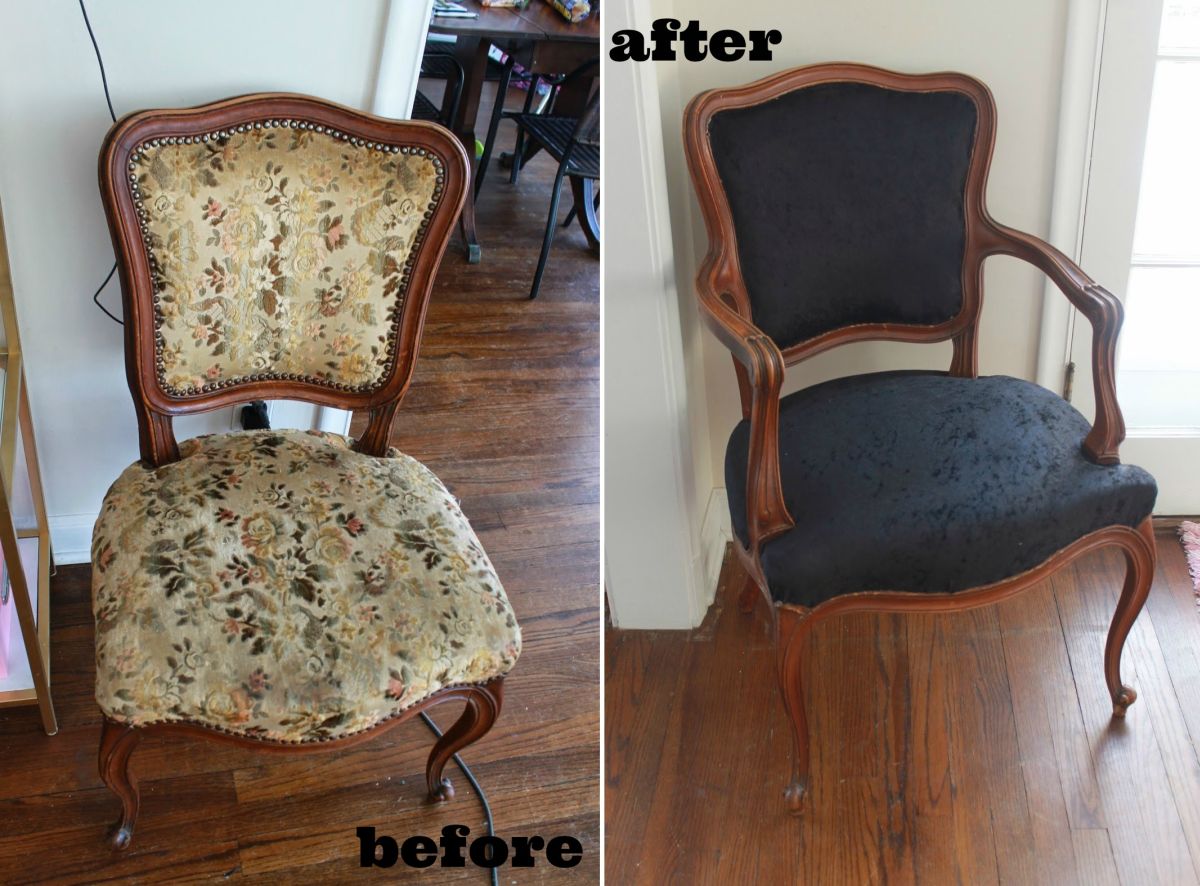
 Beginners Guides3 weeks ago
Beginners Guides3 weeks agoHow to Reupholster a Chair With Buttons
-

 Beginners Guides3 weeks ago
Beginners Guides3 weeks agoHow to Bake Acrylic Paint on Ceramic Mugs
-

 Vetted4 weeks ago
Vetted4 weeks ago15 Best RTA Cabinets to Transform Your Kitchen Space
-

 Vetted3 weeks ago
Vetted3 weeks ago15 Best Care Packages to Show You Care: Thoughtful Gift Ideas for Every Occasion
-

 Vetted4 weeks ago
Vetted4 weeks ago15 Best Backer Boards for Showers to Ensure a Waterproof and Durable Installation
-

 Vetted3 weeks ago
Vetted3 weeks ago15 Best Hypoallergenic Mattresses for a Cozy and Allergy-Free Sleep Experience











